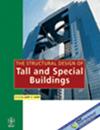Seismic design and assessment for midrise buildings equipped with damped‐outrigger system
IF 1.3
3区 工程技术
Q3 CONSTRUCTION & BUILDING TECHNOLOGY
引用次数: 0
Abstract
The damped‐outrigger system has been proposed to improve the performance of conventional outrigger systems in controlling the structural seismic response by increasing the damping and stiffness. The purpose of this study is to demonstrate the effectiveness of using damped‐outrigger systems in midrise buildings and provide engineers with a comparison between conventional structural systems such as moment resisting frame (MRF) and buckling‐restrained braced frame (BRBF) in proposing the most suitable structural system. In this study, the buckling‐restrained brace and viscous damper are adopted as the energy dissipation devices in the damped‐outrigger system. A total of 48 midrise numerical models with various building heights and structural systems are analyzed using nonlinear response history analysis and incremental dynamic analyses. The analysis results show that the midrise buildings equipped with a damped‐outrigger system with either viscous damper or buckling‐restrained brace (BRB) can reach similar and even better seismic performance when compared with the BRBF; it also reduces the structural responses by around 30% for the maximum roof drift and acceleration responses when compared with MRF. The analysis results could provide a reference for structural engineers when selecting suitable lateral force resisting systems for midrise buildings.装有阻尼支腿系统的中高层建筑抗震设计与评估
阻尼支腿系统已被提出,通过增加阻尼和刚度来提高传统支腿系统在控制结构地震响应方面的性能。本研究的目的是证明在中高层建筑中使用阻尼支腿系统的有效性,并为工程师提供传统结构系统(如抗弯框架(MRF)和屈曲约束支撑框架(BRBF))之间的比较,以提出最合适的结构系统。在本研究中,阻尼支腿系统采用了屈曲约束支撑和粘性阻尼器作为消能装置。采用非线性响应历史分析和增量动力分析方法,对48个不同建筑高度和结构体系的中高层数值模型进行了分析。分析结果表明,与BRBF相比,采用粘性阻尼器或屈曲约束支撑(BRB)的阻尼支腿系统的中高层建筑可以达到类似甚至更好的抗震性能;与MRF相比,它还将最大屋顶漂移和加速度响应的结构响应降低了约30%。分析结果可为结构工程师选择合适的中高层建筑抗侧力体系提供参考。
本文章由计算机程序翻译,如有差异,请以英文原文为准。
求助全文
约1分钟内获得全文
求助全文
来源期刊
CiteScore
5.30
自引率
4.20%
发文量
83
审稿时长
6-12 weeks
期刊介绍:
The Structural Design of Tall and Special Buildings provides structural engineers and contractors with a detailed written presentation of innovative structural engineering and construction practices for tall and special buildings. It also presents applied research on new materials or analysis methods that can directly benefit structural engineers involved in the design of tall and special buildings. The editor''s policy is to maintain a reasonable balance between papers from design engineers and from research workers so that the Journal will be useful to both groups. The problems in this field and their solutions are international in character and require a knowledge of several traditional disciplines and the Journal will reflect this.
The main subject of the Journal is the structural design and construction of tall and special buildings. The basic definition of a tall building, in the context of the Journal audience, is a structure that is equal to or greater than 50 meters (165 feet) in height, or 14 stories or greater. A special building is one with unique architectural or structural characteristics.
However, manuscripts dealing with chimneys, water towers, silos, cooling towers, and pools will generally not be considered for review. The journal will present papers on new innovative structural systems, materials and methods of analysis.

 求助内容:
求助内容: 应助结果提醒方式:
应助结果提醒方式:


